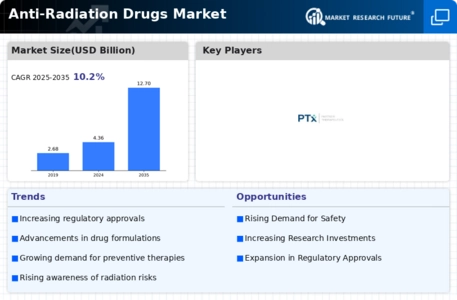Leading market players are investing heavily in research and development in order to expand their product lines, which will help the Anti-radiation drugs market, grow even more. Market participants are also undertaking a variety of strategic activities to expand their global footprint, with important market developments including new product launches, contractual agreements, mergers and acquisitions, higher investments, and collaboration with other organizations. To expand and survive in a more competitive and rising market climate, Anti-radiation drugs industry must offer cost-effective items.
Manufacturing locally to minimize operational costs is one of the key business tactics used by manufacturers in the global Anti-radiation drugs industry to benefit clients and increase the market sector. In recent years, the Anti-radiation drugs industry has offered some of the most significant advantages to medicine.
Major players in the Anti-radiation drugs market, including Amgen Inc., Anbex Inc., Arco Pharmaceuticals LLC, BTG International Inc., Cellphire, Inc., Chrysalis BioTherapeutics, Inc., Darnitsa, Enzychem Lifesciences Corporation, Humanetics Corporation, Mission Pharmacal Company, Myelo Therapeutics GmbH, Partner Therapeutics, Pluri Inc. and others, are attempting to increase market demand by investing in research and development operations.
Modern human pharmaceuticals are discovered, created, produced, and sold by a biotechnology company called Amgen Inc. (Amgen) to treat people with life-threatening disorders. It develops novel drugs in the therapeutic areas of cardiovascular disease, oncology/hematology, inflammation, bone health, neurological disorders, and nephrology. The company develops solutions using cutting-edge human genetics to investigate illness concerns and comprehend the fundamentals of human biology. Amgen mostly deals with US pharmaceutical wholesalers when selling its products. Additionally, it uses partnerships with other companies and direct-to-consumer platforms to market some products to clients directly.
Australia, North America, Europe, the Middle East, and Asia-Pacific are among the regions where the firm operates. Amgen's headquarters are in Thousand Oaks, California, in the US.
Mission Pharmacal Co. is responsible for the development, manufacturing, and marketing of prescription, over-the-counter, and dietary supplement products. It offers remedies for conditions related to urology, dermatitis, and women's health, among other conditions. Additionally, it offers contract manufacturing services. Among the many formats in which Mission Pharmacal's products are made and distributed are powders, pills, solutions, creams, lotions, gels, and suspensions. The company serves both domestic and international markets through its network of sales and distribution. The company has warehouses and production, research and development facilities in Texas. The corporation is based in San Antonio, Texas, in the United States.


















Leave a Comment